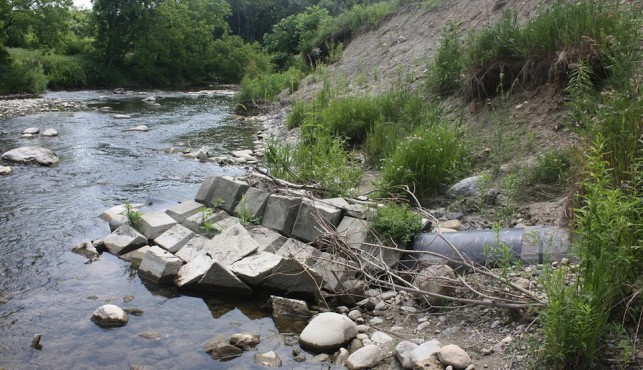There’s been a tremendous amount of media coverage surrounding Enbridge’s Northern Gateway pipeline proposal, which spawned an incredible resistance movement led primarily by indigenous nations of British Columbia. Events such as Defend Our Coast attracted thousands of protestors, while the Yinka Dene Alliance made national headlines with their anti-pipeline tour across Canada.
There’s been a tremendous amount of media coverage surrounding Enbridge’s Northern Gateway pipeline proposal, which spawned an incredible resistance movement led primarily by indigenous nations of British Columbia. Events such as Defend Our Coast attracted thousands of protestors, while the Yinka Dene Alliance made national headlines with their anti-pipeline tour across Canada. All this, of course, follows in the wake of the thousands who demonstrated outside of the White House in opposition to the Keystone XL pipeline.
Facing mounting pressure, oil companies are looking eastward in an effort to continue moving their product; tellingly, author and activist Maude Barlow recently remarked to a Toronto crowd, “Pipelines are like the arteries of the tar sands.” Although communities in Ontario and Quebec are mobilizing to block eastern pipelines from facilitating tar sands expansion, the task is proving to be a challenge due to fast-paced assessments and a public that is ignoring the bigger picture of tar sands and climate change.
Line 9 is the main artery that would transport tar sands crude oil across eastern Canada, a pipeline that runs from Sarnia, Ontario to Montreal, Quebec and which would then travel through New England to Portland, Maine to be refined and exported. Passing within 50 km of 115 communities, eighteen of which are First Nations, Line 9 will ship 300,000 barrels of crude oil per day along its entire length. Built in 1975, Line 9 traditionally carried conventional crude oil from east to west. In July 2012, the National Energy Board (NEB) approved the reversal of the first phase of the pipeline, which travels from Sarnia to a suburb of Hamilton.
The approval marked the two-year anniversary of the infamous Enbridge Kalamazoo oil spill, in which 3.3 million litres of diluted bitumen spilled into the Kalamazoo River near the town of Marshall, Michigan. Because of its chemical attributes, bitumen reacts differently in water than conventional crude oil does. Bitumen is a solid at room temperature, and so it is mixed with a natural gas condensate in order to decrease its viscosity. When the high pressure pipeline burst in 2010, the bitumen sank to the bottom of the river, while the light-weight gas evaporated in the air.
Not only was the spill incredibly hard to clean up due to the sinking of the heavy bitumen, but the residents of Marshall were poisoned by the toxins in the air. Documents from Enbridge note that diluted bitumen – an acidic blend that contains 15 to 20 times higher acid concentrations than regular crude, as well as 5 to 10 times as much sulfur – could very well be shipped through Line 9.
Alarmingly, the burst pipeline was built in 1969, just six years before Line 9. It was also constructed with the same polyethylene tape coating, and with a diameter-to-thickness ratio that categorizes it as a “thin-walled” pipeline. Activists fear that these similarities could result in another tragic spill, what with the pipeline crossing a dozen significant watersheds that drain into the Great Lakes. The Great Lakes, and these watersheds, provide drinking water for millions of people. With the second phase of Line 9 slated for public hearings in early 2013, organizers are scrambling to keep up with the pace of the NEB.
Most concerning is the lack of public dialogue on what these pipelines ultimately mean for Canada and the United States. The expansion of the tar sands giga-project not only perpetuates a seemingly endless dependency on dirty fossil fuels, but also subjects our planet to slow industrial genocide from greenhouse gas emissions. The average carbon emissions for tar sands extraction are estimated to be 3.2 to 4.5 times higher per barrel than conventional crude oil. As well, the long-term impacts of tar sands mining on the Peace-Athabasca Delta watershed and local ecosystems are extensive.
Finally, two damning reports published last week provide strong evidence to show that the environmental impacts of the Keystone XL project are worse than previously estimated. Both studies confirm that the levels of emissions of the tar sands are dangerously high, one of which asserting that they are even higher than previously accounted for due to a by-product called petcoke. With these facts in mind, it is absurd that the tar sands are still being entertained as a viable energy option – an option that we are to accept being distributed across the continent through unreliable pipelines.
The upcoming National Energy Board (NEB) hearings for the second phase of Line 9 pose an opportunity for people of Ontario and Quebec to engage in public dialogue about the nature of the tar sands industry, pipeline safety, climate change, and First Nations treaty rights. The question still remains whether or not we will passively accept Line 9 as a facilitator for the expansion of the oil industry.
If you reject Line 9 and eastern expansion, you can check out this week’s solidarity actions in support of New England activists. Organize a similar solidarity action in your city; or assert your right to public participation by registering as an official intervenor in the NEB hearings. Like the thousands in British Columbia and Washington, it is vital that we mobilize our communities to stop the flow of tar sands oil across the east coast. Here is your call to action: “Block ‘em in the west, block ‘em in the south, block ‘em in the east!”
Paisley Cozzarin is an outreach campaigner for Environmental Defence Canada, an English Literature & Rhetoric major at the University of Waterloo. She is a member of the WPIRG Board of Directors and founder of Stop the Tar Sands KW.
Paisley was interviewed by Dan Kellar of the Grand River Media Collective for our Education podcast, which you can listen to here.
The photo above is from a series of photos taken by Environmental Defence’s Climate & Energy Program Manager, Adam Scott.
Paisley Cozzarin is an outreach campaigner for Environmental Defence Canada, an English Literature & Rhetoric major at the University of Waterloo. She is a member of the WPIRG Board of Directors and founder of Stop the Tar Sands KW.













